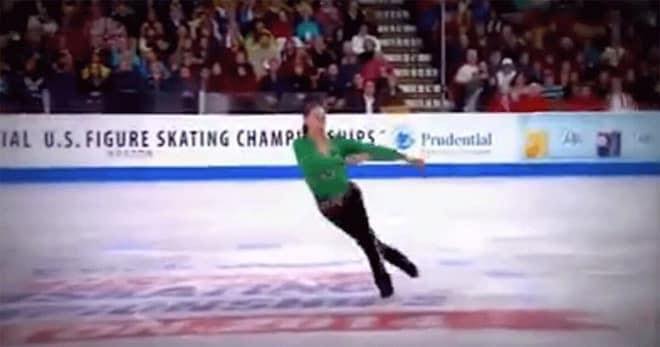When it comes to unforgettable performances, few moments in figure skating history have captured hearts quite like Jason Brown’s Riverdance routine at the 2014 U.S. Figure Skating Championships. It wasn’t just a skating performance—it was a breathtaking fusion of Irish step dance and the artistry of figure skating, leaving both the live audience and millions of online viewers absolutely spellbound. Years later, this performance still resonates, celebrated for its originality, precision, and Jason’s undeniable charisma.

It all started with an ambitious idea. Jason, already a rising star in the figure skating world, was working tirelessly on a new routine under the guidance of his coach and choreographer. Then came a suggestion that stopped him in his tracks: “Why not skate to ‘Reel Around The Sun’ from Riverdance?” At first, Jason was incredulous. The idea of blending the rapid, intricate rhythms of Irish step dance with the graceful yet technical demands of figure skating seemed almost impossible. But as he began to work through the choreography, Jason realized that this challenge was something special. It was an opportunity to create something truly unforgettable.
For those unfamiliar, Riverdance became a global phenomenon after its debut in 1995, captivating audiences with its electrifying blend of music, synchronized footwork, and cultural pride. Translating that energy onto ice was no small task. The precision and quick rhythms of Irish dance rely heavily on footwork—something incredibly difficult to replicate on skates, where control, balance, and speed are already precarious. Yet Jason, with his exceptional talent and unwavering determination, took on the challenge and turned it into a masterpiece.
When the day of the performance arrived, the arena buzzed with anticipation. Fans packed the stands, eagerly awaiting what they knew would be a memorable routine. As the opening notes of “Reel Around The Sun” echoed through the arena, Jason took his first gliding steps across the ice. Immediately, the energy shifted. There was an undeniable connection between Jason and the music—a seamless harmony that set the stage for what was about to unfold.
Jason’s skating was nothing short of mesmerizing. His sharp, lightning-fast footwork was perfectly synchronized with the spirited rhythm of the music. Every jump, every spin, and every glide felt intentional, each movement contributing to the larger story he was telling on the ice. His arms moved fluidly, complementing the sharpness of his steps, and his facial expressions radiated joy and passion. It wasn’t just a technical routine—it was an emotional performance that transcended the boundaries of sport and art.
What made this performance particularly groundbreaking was the sheer difficulty of translating Riverdance into skating choreography. Irish step dance is famously rigid and precise, with much of the energy focused on the feet while keeping the upper body relatively still. On ice, where skaters rely on fluid movements and sweeping gestures for balance and flow, this seemed almost contradictory. But Jason navigated this contrast with elegance and precision. His feet tapped and twinkled across the ice, perfectly mirroring the quick tempos of the music while maintaining the grace and athleticism expected of elite figure skating.
As the performance reached its crescendo, the audience’s excitement became palpable. Cheers echoed through the arena, and by the time Jason struck his final pose, the crowd erupted into a standing ovation. The applause was deafening, and the emotional energy in the building was overwhelming. Jason skated to the edge of the rink, visibly moved by the audience’s response, his face reflecting a mix of joy, relief, and gratitude.
But Jason’s moment of triumph wasn’t limited to the live audience. A video of his performance was uploaded online shortly after the championships, and it quickly went viral. Millions of people from around the world clicked play, captivated by the extraordinary fusion of Riverdance and figure skating. The comment sections were flooded with praise, admiration, and gratitude for Jason’s ability to create such a unique and emotional experience. Even seasoned commentators, who had seen countless performances throughout their careers, couldn’t hide their awe at what Jason had achieved.
One of the most touching moments in the video comes after Jason’s final bow. As the applause continues, he looks genuinely overwhelmed by the love pouring in from the audience. It’s a raw, human moment that perfectly encapsulates why his performance struck such a chord with so many people—it was authentic, heartfelt, and executed with extraordinary talent.
This routine wasn’t just about showcasing technical prowess; it was about storytelling through movement. Jason didn’t just skate to music—he embodied it. The energy of Riverdance, the spirit of Irish tradition, and the beauty of figure skating all came together in perfect harmony. It was a reminder of what makes figure skating such a powerful art form—it’s not just about jumps and spins, but about creating moments that linger in people’s hearts long after the music stops.
Years later, Jason Brown’s Riverdance performance remains one of the most iconic moments in figure skating history. It’s a testament to his talent, his courage to step outside the box, and his ability to connect with people through his craft. For anyone who has ever watched it—whether live in the arena or through a screen—it’s a performance that’s hard to forget.
If you haven’t seen it yet, you’re truly missing out on one of the greatest performances ever captured on ice. Jason Brown’s Riverdance routine isn’t just a skating performance—it’s an experience. It’s a beautiful reminder of what happens when passion, creativity, and talent collide to create something truly extraordinary.
So, take a moment, find the video, and let yourself be swept away by the magic of Jason Brown’s unforgettable performance. You’ll quickly understand why millions of people around the world have been left in awe by this breathtaking display of artistry and athleticism.





